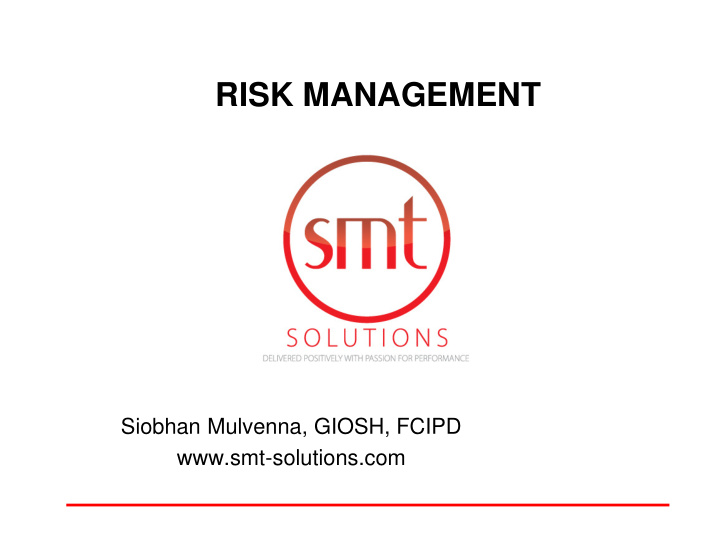



RISK MANAGEMENT Siobhan Mulvenna, GIOSH, FCIPD www.smt-solutions.com
What is Risk Assessment? • Like any other area of your business, health and safety needs to be properly managed. • To do this you need to know what the main hazards and risks are within your business so that you can control them effectively.
D Definitions Hazard �������������������������������� ���������� Risk ����������������������� ��������� Risk assessment ����������������������������� ����� Control measure �����������������������������
Risk assessment ������ Potential to cause harm ���� Likelihood of harm from that hazard • This depends on: � Likelihood or frequency of the harm occurring � Severity of the harm or injury � Number of people exposed.
Hazard and risk – a practical example Hazard – the damaged floor has the potential to cause harm Risk – (likelihood it will cause harm) depends on several factors • Extent of damage • Nos walking over it, how often, what they are wearing and level of lighting
Risk Assessment Template
Five steps to risk assessment ! Identification of hazards, calculation of risk and reduction of risk PRINCIPLES OF RISK ASSESSMENT Identify hazards 1 Identify those who may be harmed 2 Evaluate risk by considering existing precautions 3 Record the findings 4 Review and revise as necessary. 5
Step 1 Identify the hazards
Identify the hazards Step 1 Fire Noise Electricity Machinery Poor lighting Manual handling Working at height Slips and trips High or low temperatures Dust, fumes and poor ventilation Chemicals.
Categorizing Hazards Physical Chemical Biological •Moving •Solvents •Viruses e.g. machinery hepatitis B, AIDS •Acids •Electricity •Bacteria e.g. •Caustics legionella, e-coli •Incorrect manual •Dyes handling •Fungi e.g. •Glues athletes foot •Internal transport •Cleaning agents •Micro-organisms •Poor e.g. humidifier housekeeping •Faulty equipment
Categorizing Hazards Ergonomic Environmental Psychosocial •Repetitive •Noise •Stress movements •Pressure •Violence •Radiation •Shift work •Long Hours •Non work related problems •Intense physical/mental activity
Invisible hazards ! • Noise • Dust • Mists – fumes – gases – vapours • Unsuitable lighting • Vibration • Extremes temperature • Sources of radiation • Injury through poor design of tasks and machinery
Step 2: Who might be harmed and how? • non-employees • Visitors (authorised) • Public • Emergency services • Other employees • Colleagues • Employees from other sites • Special groups
Step 3: Evaluate the risk
Evaluate the risk Step 3 ? Are existing precautions and control measures satisfactory? If not… can they be improved? Do they: • reduce the risk • comply with the law • represent good practice?
Evaluate the risk Step 3a ? Are existing precautions and control measures satisfactory? If not… can they be improved? Have the staff: � ����������������� � �������������������� � ������������������� � ����������������������������������� � �����������������������
Hierarchy of control Step 3a • Elimination – do you have to do this task, use this area, substance or machinery, or lift the box • Substitution – can you use less hazardous substances e.g. non-irritant? Can you use a trolley or lifting equipment that will do the job with less risk? • Enclosure – can the hazard be put in another area where people are not exposed to risk? Can you put up fencing or enclose it? • Isolation. – do people have access to the area or equipment? Can you switch it off when ot in use?
Hierarchy of control Step 3a • Ventilation – increased general ventilation or specific local exhaust ventilation, would this reduce the risk. • Good housekeeping reduces risk • Time control – how long is someone exposed to the risk? Could it be reduced? • Training – ensure all staff are competent to do their tasks • Personal protective equipment (PPE) – this is the last resort, always reduce the risk at source first.
Step 4: Record the findings
Record the findings Step 4 ! A legal requirement if more than five employees
Review and revise if necessary Step 5 Review • Regularly • If changes in the workplace occur • After an accident or near miss.
Some common examples Who When is What are the hazards? Who might be harmed What are you already doing? What further action do needs to the Done and how? you need to take? carry out action the needed action? by? Slips and Trips Staff and visitors may Good general housekeeping. Better All staff and From 01/09/1 • • be injured if they trip All areas well lit, including housekeeping in supervisor now on 0 • over objects or slip on stairs. staff kitchen to monitor spillages. No trailing leads or cables. needed, eg on • Staff keep their work areas spills. • clear, eg no boxes left in walkways, deliveries stored immediately. Arrange for loose Manager From 02/09/1 • Offices cleaned every evening. carpet tile on now on 0 • second floor to be repaired / replaced.
Some common examples When is Who needs What are you already doing? Done What are the Who might be harmed What further action do the action to carry out hazards? and how? you need to take? needed the action? by? Manual Staff risk injuries or back Trolleys used to transport boxes of Remind staff that Manager 04/09/10 02/09/1 • • 0 handling of pain from handling heavy and other heavy items when they should not try equipment collecting deliveries etc. / bulky objects, eg to lift objects that etc. deliveries of High shelves for light objects only. look or appear too • paper/product/machinery. heavy to handle.
Some common examples
Some common examples
�����������
Recommend
More recommend